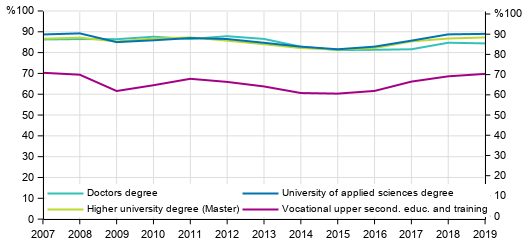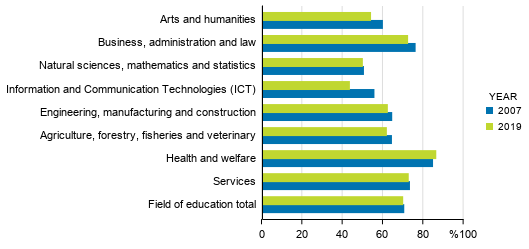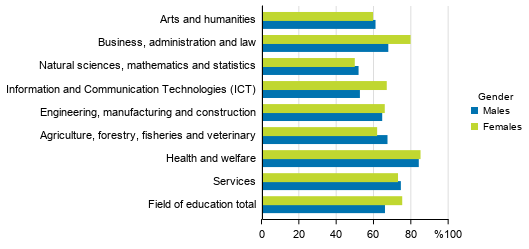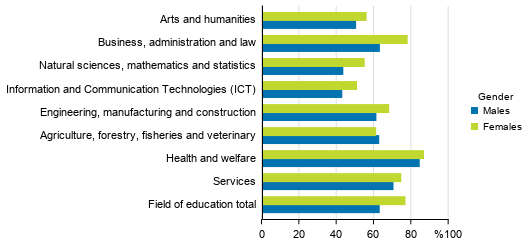Published: 21 January 2021
Employment improved among those with initial vocational qualifications, more difficult for men to find employment than for women
According to Statistics Finland's education statistics, employment of recent graduates improved further. Those with tertiary level degrees were most successful in gaining employment, close to 90 per cent of whom were working at the end of 2019. Seventy per cent of those with initial vocational education were employed, which is the same share as in 2007.
Employment of graduates one year after graduation 2007–2019, %

Employment among recent graduates is measured one year after their graduation Of graduates, 73 per cent were working one year after graduation, 58 per cent were working full-time and 14 per cent were working besides studies. The share of full-time employees had grown by one percentage point from the previous year. The share of the unemployed was eight per cent.
Employment of recent graduates with initial vocational qualifications on level with 2007
Seventy per cent of those with initial vocational qualifications were employed, 77 per cent of women and 63 per cent of men. Fourteen per cent were unemployed, 10 per cent of women and 18 per cent of men. After the initial vocational qualification, 16 per cent continued studying, slightly over one-half of them alongside working. Of women, 11 per cent continued studying alongside work and of men six per cent. Twelve per cent of men were in the group others, which includes non-military and military service, for example.
In 2007, the share of employed was also 70 per cent, 75 per cent of women and 66 per cent of men. Ten per cent were unemployed, nine per cent of women and 11 per cent of men. After the initial qualification, 20 per cent continued studies, of which slightly over one-half were studying while working. Thirteen per cent of women and nine per cent of men continued studying while working. Of men, 16 per cent were in the group others, which includes non-military and military service, for example.
Employment of graduates with initial vocational qualification, 2007 and 2019, %

Those with initial vocational qualifications in the field of health and welfare found employment easiest, 86 per cent of whom were employed in 2019, up by one percentage point from 2007. Employment was found second most successfully by those with qualifications in services, 73 per cent of whom were employed. Of those with qualifications in business, administration and law, 72 per cent were working. Employment was weakest among those with qualifications in information and communication technology (ICT), of whom 43 per cent found employment, the drop from 2007 amounted to 13 percentage points. The fields of education with the highest numbers of qualifications were technology, and health and welfare. Health and welfare was the only field of education where the employment of those with qualifications improved compared with 2007.
Employment of graduates with initial vocational qualification by gender, 2007, %

In 2007, a total of 75 per cent of those with initial vocational qualifications were employed women among recent graduates with initial vocational qualifications, while the corresponding share for men was 66, so the difference in employment rates was nine percentage points. Both men and women with qualifications in the fields of health and welfare found employment best, 85 per cent of women and 84 per cent of men. Employment was weakest in natural sciences, where 49 per cent of women and 51 per cent of men with a qualification had found work. However, measured by the number of qualifications, natural sciences is a small field. In absolute numbers, most employed women came from the field of health and welfare, while the most popular field for men was technology.
Employment of graduates with initial vocational qualification by gender, 2019, %

In 2019, altogether 77 per cent of those with initial vocational qualifications were employed women, while the corresponding share for men was 63 per cent, so the difference in employment rates was 14 percentage points. Both men and women with qualifications in the fields of health and welfare found employment best, 87 per cent of women and 84 per cent of men. Employment was weakest in information and communication technology, where 51 per cent of women and 43 per cent of men with a qualification found employment. The strong segregation of fields of education continued and the highest number of employed women graduated in the field of health and welfare, while the most popular field for men was technology.
Compared to 2007, the employment of recent female graduates has improved by two percentage points, while that of men has weakened by three percentage points. The differences between genders in the labour market outputs of initial vocational education have thus grown even further. Women's employment also improved in the male-dominated field of technology: 66 per cent of graduates in the field of technology found employment in 2007, while in 2019 the share was 68 per cent. In turn, men's employment in the field of technology decreased by three percentage points over the review period. Among the fields of education, men's employment improved or remained unchanged only in the field of health and welfare. The biggest drop in men's employment concerned those with qualifications in information and communication technology, of whom nine percentage points fewer were employed than in 2007.
The majority of those having passed the matriculation examination were continuing studies one year later, although only 30 per cent continued studies immediately after the matriculation examination, see Entrance to education . One year after the matriculation examination, 53 per cent of passers of the matriculation examination continued studies leading to a qualification or degree, 57 per cent of women and 48 per cent of men. In addition to further studies, 18 per cent were working, 23 per cent of women and 11 per cent of men.
In all, 89 per cent of those with university of applied sciences degrees had found employment within one year and 88 per cent of those with higher university degrees. Five per cent of those with university of applied sciences and higher university degrees were unemployed. Among those with higher university of applied sciences degrees, 95 per cent were working one year after graduation, as many women as men, and three per cent were unemployed. Of recently graduated doctors, 85 per cent were working, 87 per cent of women and 84 per cent of men. The share of the unemployed was five per cent.
In most university education, the right to study is for a higher university degree. For that reason, the majority of recent graduates with lower university degrees continued studies (89 per cent), as many women as men. Over one-half were also working besides studies (56 per cent).
More detailed data on the employment of recent graduates by region of residence, age, level and field of education can be found in the database tables .
Source: Education 2021. Statistics Finland
Inquiries: Mika Witting 029 551 3530, koulutustilastot@stat.fi
Head of Department in charge: Hannele Orjala
Publication in pdf-format (286.8 kB)
- Tables
-
Tables in databases
Pick the data you need into tables, view the data as graphs, or download the data for your use.
Appendix tables
Updated 21.1.2021
Official Statistics of Finland (OSF):
Transition from school to further education and work [e-publication].
ISSN=1798-9469. 2019. Helsinki: Statistics Finland [referred: 31.12.2025].
Access method: http://stat.fi/til/sijk/2019/sijk_2019_2021-01-21_tie_001_en.html

